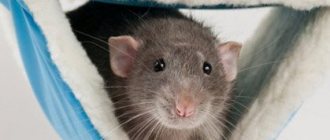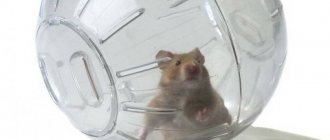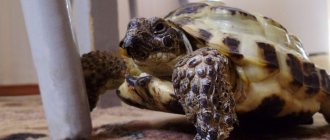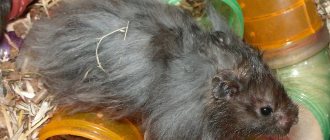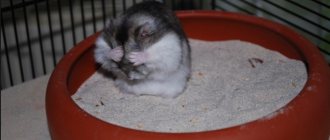Temperature fluctuations, daylight hours - all this affects rodents. Once you find the motionless body of your beloved homa in a cage, you shouldn’t immediately get scared. Few people know that hamsters, even living at home, can sometimes fall into stupor. This is not a seasonal long hibernation, like that of a bear. A hamster physiologically cannot accumulate enough nutrients in its body to fall into a sweet, carefree sleep for several months. This could be fatal for him.
With this article we want to help the owner of a tame hamster, so as not to “break the woods” in the situation that has arisen, or to mistakenly bury a sleeping pet.
Do hamsters hibernate: in nature and at home
In nature
When the temperature outside drops, Homa understands that it’s time to get some sleep.
In nature, hamsters, like many small rodents, climb into a deep, warm hole during the cold period of time, which they dig in the ground at a depth of 1-2 meters. In his “apartment,” in addition to the living room where he rests, there is also a chamber designed for storing supplies, which the owner periodically visits in winter during periods of wakefulness. His provisions consist of vegetables, root vegetables, stolen from farmers' fields, as well as berries, fruits, and grains.
Few people also know that hamsters are far from vegetarians. In the wild, they are aggressive and very dangerous predators. And on occasion, they enjoy feasting on caught insects and small animals.
The hamster emerges from its winter burrow no earlier than the end of February, when the earth finally freezes. At the same time, his “sleepy” period has long passed.
After him, the “cheeky, furry owner” waits for some time and does not appear on the surface of the earth. It feeds on what is left in its pantry, and only after a month does it open the entrances to its burrow.
There is no young greenery in the fields yet, and at first he has to eat what he finds on the ground after the snow melts - last year's seeds or berries that fell from the bushes.
Females emerge from winter shelters even later - at the beginning of the mating season.
At home3>
The onset of hibernation is a protective reaction of the rodent’s body from unfavorable conditions for life: lowering the temperature, decreasing the amount of sunlight, lack of food in nature. Therefore, it is most likely that your hamster will “decide to sleep off in winter” if:
- Hamsters are big sleepyheads. you keep it in a cool room: if the temperature can drop to +15 degrees, stupor cannot be avoided;
- a cage with a hamster is in your bedroom, in which, when you leave for work in the morning, you do not open the window shades;
- the animal has to endure long-term transportation or some other stress during the cold season;
- lack of vitamins and nutrients in the rodent menu.
Numbness, hibernation is a slowdown of all vital processes in the body.
Main signs of numbness
- The heart begins to beat much less frequently; its beats may not be audible at all.
- The body cools down.
- The muscles become stiff.
In a word, all signs of lifelessness appear.
What should be in a hamster's cage?
Walk
When you see a hamster gnawing doomedly at the bars of its cage, does your heart clench with pity? Do you feel that your hamster needs freedom, so every evening you let him out for a walk and watch with affection as he gets stuck under the closet or falls from the curtain? Whether or not to let your hamster out for a walk is up to you, but the best thing you can do is buy a ball for walking or fence off a safe area with enclosures. Believe me, there is no hole that a hamster cannot fit through. Although it seems to you that your pet is a fat, overfed hog, in fact, at the right time he can become very flat, so it is better not to let him roam freely. Otherwise, you risk finding it on the cabinet, in a pot of fish, or, God forbid, in your underwear drawer. Yes, a hamster can do it.
Sleeping or dead?
This is not difficult to determine. The main thing is to be patient.
- In a state of torpor, the hamster’s body, although cold, hard and motionless, can still hear its heartbeat. It is rare - only a few beats per minute.
- The animal also occasionally continues to inhale and exhale. Hold a mirror to its muzzle: if the hamster is alive, after some time traces of fogging will appear on the glass from its breathing.
What else should you expect?
At first, your hamster will be lethargic. He will likely be lying on his stomach with his limbs extended. The more he wakes up, the more active his movements will be. The first sign of waking up is twitching of the eyes and whiskers. Then he will be able to raise his head, but not for long.
Then, when the hamster can hold his head up, he will make an attempt to sit down and begin to walk, slowly, swaying from side to side until he eventually gains control of his body. He will shiver a little for a while, but this is quite normal as his body temperature rises to normal and his muscle tissue begins to contract.
It may take more than three hours for your hamster to wake up, and during this time continue to warm, rub, water and feed him. You don't have to worry, the hamster will soon come to his senses and be the same as before. If within the first hour you do not find any improvement in your hamster’s condition, immediately contact an emergency veterinary service.
Is it worth waking up?
Hamster breeders do not give a clear answer to this question. You will have to make a decision yourself, based on the data presented below.
Not worth it
On the one hand, in nature, a hamster approaches hibernation consciously and with full responsibility. He conscientiously eats up the subcutaneous fat layer so that he has something to eat in his sleep.
And there is an opinion that if the hamster is not woken up, unprepared - not well fed - he may simply die in his sleep. But in nature, when he gets hungry, he wakes up and “stomps into his pantry to inspect the supplies”! What's stopping him from doing this in a cage?!
Proponents of not forcibly removing a hamster from a state of “sleepy coma” believe that all life processes in the body should occur naturally, without external gross interference. Hibernation can last from several hours to several days.
By the way, what speaks in favor of rodent hibernation at home is the fact that those of them who “switch off” in winter live longer lives than those who “don’t sleep” in the cold season. True, winter sleep in animals negatively affects the appearance of cubs: they are born less often and in smaller numbers.
If you decide not to wake your pet, help him wake up comfortably. Insulate the cage, for example, put a lot of cotton wool in it and carefully immerse the hamster in it.
Nearby, prepare a “self-assembled tablecloth” with delicacies for him, so that when he wakes up, he can refresh his strength.
Is it possible to train a hamster?
Costs
The baby, numb from the cold, needs to be woken up. In making such a decision, the fact that at home there is absolutely no need for a hamster to hibernate often plays a role.
And his further rhythm of life should not be disrupted by such a random incident.
The owner corrects errors in care, “revives” the pet and no longer allows it to “fall asleep.”
What care does a hamster need after waking up?
Once your hamster is confidently on his feet, place him back in his cage in a warm, quiet place. Leave him plenty of food and water and allow him to finish his recovery in his own way.
Give him plenty of fresh materials or toilet paper to build a warm nest. He will still be very weak, so shred the paper to make it easier for him to build a nest.
Check him every hour and the next day too, or at least half a day, to make sure everything is fine and he hasn't gone into hibernation again. Don't be surprised if within a few hours you find him spinning his favorite wheel.
Source
How to wake up
It is necessary to create conditions that are exactly the opposite of those in which the hamster went into torpor. Move the cage to a brighter and warmer room, with an air temperature not lower than +20-22 degrees. You can put his favorite “snacks” next to his nose.
The hamster can be wrapped in a warm cloth or placed in cotton wool. And, of course, give him more food so that after waking up he can replenish his strength.
Don’t expect that when you come to your senses, your homeboy will immediately start spinning his favorite wheel. For some time he will behave sluggishly, rest a lot, and only after a day or two all life processes will resume in the same rhythm.
Under no circumstances should you try to warm up your hamster using radiators or electric heaters. Such extreme awakening can only cause harm. A numb body has a lower pain threshold, and the animal will not be able to let you know that it is too hot. The experiment may even end in the death of the pet.
Recommended sequence of actions and process features
So, in addition to running water, soda and citric acid, we will need a thin brush or a strong fishing line with a soft, lint-free rag. If you follow all the recommendations correctly, the desired result can be achieved without much hassle in a quarter of an hour. To clean the hookah, you must perform the following manipulations:
- Remove the foil from the hookah bowl and remove all remaining tobacco mixture. It is best to use a soft brush or cloth for this.
- We disassemble the structure into its component parts as much as possible, pour out all the liquid from it.
- Next, we assemble the device again, attach its mouthpiece to the water tap and let in the liquid. We make sure that the water flows in the direction opposite to the movement of smoke while smoking a hookah.
- Next, we replace the mouthpiece with the upper part of the shaft and continue the process, but now in the opposite direction. The stage using clean running water should last at least 8-10 minutes. We remember that, if possible, the liquid should be as hot as possible (if the material of the elements allows it).
Mine cleaning
- Next, we disassemble the hookah again, now we need to clean all its parts separately.
- First we are working on the hose, for which we will need a very thin brush with soft bristles and a long handle. If you use a regular brush, you can damage the rubber. The use of wire can also cause damage to the material in case of careless movements. It is best to use a profile device or wire securely wrapped in rags. We move the device back and forth for a couple of minutes, if necessary, changing the fabric or washing the bristles of the brush. You need to blow out the hose or rinse it several times to finally get rid of dirt and deposits.
Cleaning the hose
Next, we begin to process the bowl using a clean cloth and household chemicals. First, prepare a solution of weak concentration, pour it into a bowl, leave for a couple of minutes, drain and clean with a cloth soaked in the same composition. If necessary, repeat this several times or increase the concentration of active substances. Next, be sure to rinse everything with clean water.
Cleaning the flask
After the cleaning procedure is completed, you must use a clean, soft and dry cloth to remove excess moisture from all accessible surfaces of the hookah parts. If this is not done, they will gradually oxidize and become unusable.
Today, specialty stores offer specialized hookah cleaning products. From a practical point of view, they are very convenient, they thoroughly wash away dirt and do not leave behind an unnecessary aromatic trail. True, they cost a lot, are consumed quite actively, and their shelf life expires a few weeks after the first use. Therefore, if the hookah is not used very often, it is better to limit yourself to using familiar household chemicals.
We suggest you familiarize yourself with the shape of napkins for the table
All breeds are dormouse!
The most popular types of hamsters for home breeding include:
- Syrian;
- Djungarian;
- long-tailed;
- ordinary;
- angora.
Albino.
There are also so-called albino hamsters. These are also very often kept at home. Although this is not a breed, it is a biological feature of a living organism - the absence of dark pigmentation. These hamsters are pure white with a pink nose and pink eyes. All these hamsters are capable of falling into suspended animation, since this was typical for their ancestors under natural conditions. By the way, it has been noticed that most often hibernation at home “happens” to Syrian hamsters.
Habitual sleep pattern
At its core, the hamster is a nocturnal animal, both at home and in nature. At night he is awake, and during the day he sleeps.
An animal can easily sleep all day, but when night comes, he will begin to actively spin the wheel, climb in mazes and restore order in the cage. Many owners of a cute animal are not happy with this, so they try to teach it to sleep at night.
This is very difficult to do. In addition, if the owner does not allow the pet to sleep during the day, this will unsettle him. Therefore, it is better not to interfere with his usual sleep pattern.
Interesting facts: who hibernates and how
- The females of some animals “turn off their bodies” during pregnancy. When the time comes to give birth, their hibernation ends.
- Zoologists distinguish three types of hibernation among our smaller brothers: daily - it is characteristic of bats and hummingbirds, irregular - long sleep occurs in conditions unfavorable for normal existence, and seasonal.
- The ancient encyclopedist believed that even swallows could hibernate. However, recent studies have shown that among birds, hibernation in the full sense of the word (not daily torpor, but long-term sleep) is characteristic only of the white-throated nightjar.
- The cause of suspended animation in animals can be not only a decrease in air temperature, but also an increase. So, with the onset of winter temperatures in Madagascar above +30 degrees. The dwarf lemur climbs into a secluded hollow and prepares for a seven-month rest.
- Rodents store huge amounts of food during hibernation. The weight of the food can reach from 20 to... 90 kg, like that of a common hamster!
- During the period of suspended animation, some frogs cool down so much that they almost turn into a lump of ice. But with an increase in temperature, all vital functions resume.
Steps
Wake up your hamster carefully
- Talk to the hamster in a quiet, gentle voice.
Try waking your pet with the sound of your voice. Approach the cage and start speaking in a low voice. You can softly hum a song or purr a melody until your pet wakes up.
Offer your hamster a treat.
Another way to wake up your pet is to offer him some kind of treat. Try holding a treat to a sleeping hamster's face (close enough for him to smell it) - most likely, the delicious smell will wake the animal.
- As a treat, you can take a piece of vegetables (for example, carrots or broccoli) or special treats for hamsters, which are sold in pet stores.
- Blow on the animal's face.
If your pet is sleeping in the open part of the cage rather than in the house, you can wake him up by gently blowing on his face. To avoid scaring your pet, simply exhale at first and then blow a little harder, gradually increasing the intensity until the hamster begins to wake up.
Do not touch a sleeping animal.
If you are trying to wake up your pet, do not poke or prod the sleeping animal. This is a very unfortunate way to awaken a hamster, since the animal will perceive your actions as a threat and begin to defend itself. Even if the hamster wakes up, he will be in a bad mood and will not allow you to pick him up and play with him.
Move slowly.
Remember that your goal is to wake your pet without scaring him. Therefore, try not to make fast and sudden movements. On the contrary, when you approach a sleeping animal, try to move smoothly and slowly. This way you can wake him up gently and your hamster will wake up in a good mood.
Change the room temperature.
Another idea based on knowledge of hamster physiology is to wake the animal by changing the temperature in the room. As you know, a hamster's daytime sleep in a cold room lasts longer than in a warm one. You can raise the temperature of the entire room by turning on a heater, or you can heat just the hamster's cage using a special lamp or heating pad.
Shake the food bowl.
If you rattle the food bowl, the hamster will have two reasons to wake up: firstly, his sensitive ears will catch familiar sounds, and secondly, he will probably want to eat. Place some pet food in the bowl and swirl the bowl from side to side. The hamster will hear a familiar noise and wake up.
Raise your pet's house.
Very often, hamsters sleep in a small house or other shelter located inside the cage. If you want to wake up your pet, simply lift its cover. If the hamster sleeps at the bottom of the cage and is only covered at the top, you can raise the cover and move it to another place so that the hamster is in an open space. You can simply lift the shelter and return it to the same place: movement and noise will disturb the pet, and it will wake up.
Gently knock on the cage.
If you lightly tap the cage, the soft sound and vibration will simultaneously stimulate your hamster's senses. Gently run your fingers along the bars of the cage close to the sleeping animal until it wakes up.
Train your hamster to wake up at a certain time
- Find out what the term "twilight animal" means.
You can often hear that hamsters are called nocturnal animals. In fact, this is not entirely correct, since the term “twilight animal” is more correct from a biological point of view. The difference between these concepts is that truly nocturnal animals are most active in the dark, and hamsters are most active at dusk (at dusk and dawn). Try to learn more about the circadian rhythms of hamsters - this will help you better understand your pet and influence its sleep patterns.
Write down your pet's daily activity schedule.
If you want to teach your hamster to wake up a little earlier than usual so that you have more time to play with your pet, first observe the animal's behavior and create a schedule for its daily activity. Take three to five days and write down in as much detail as possible when your pet sleeps and when he is awake.
Feed your hamster at specific times.
Having compiled a table of your pet's daily activity (it is especially important to accurately determine the time when he wakes up), start feeding the hamster at the same time (as soon as he wakes up). For example, if your pet wakes up at 8:30 in the evening, set your pet's feeding time to 8:30. Follow this schedule every day for at least a week, then move on to the next step.
Start feeding your hamster a little earlier.
Try moving your feeding time forward 15 minutes. For example, after the first week, try waking your hamster up a little earlier than usual by offering him food at 8:15. Continue training your pet until he learns to wake up on his own at 8:15 (this will take about a week). After this, move the feeding time to 8:00 and continue training your pet according to the same scheme.
Be patient.
This strategy only works if you handle it delicately. So if you want to succeed, be patient. Remind yourself often that the natural circadian rhythm that causes hamsters to wake up only at dusk was formed over many years during the evolution of these animals. It would be strange if your pet was able to quickly change its essence within a few days. Accept that no matter how hard you try, you will not be able to radically influence your pet’s circadian rhythms of activity. The maximum that you can achieve as a result of training your pet is that the hamster will get used to waking up an hour earlier than the time at which you started your work.
In nature, for many animals, the cold season is characterized by a decrease in activity, and some representatives of the animal world even hibernate. Therefore, it is not surprising that the question “do hamsters hibernate – is it true or not?” interests many owners of such cute creatures.
Today, in our section about rodents, we will try to give you an answer to the question regarding the possible hibernation of hamsters, we will discuss the conditions when such hibernation can occur and we will talk about how the owner of such a sleeping hamster should behave correctly...
Schedule
We almost never see hamsters in the wild because they are nocturnal. They obtain supplies only in the dark, because this is a safe time when predators and people sleep. Domesticated rodents of various breeds are also “active” at night when people are sleeping.
Not everyone, even experienced owners, knows that domestic hamsters hibernate just like their wild relatives. The fact is that the state of torpor does not occur in all animals and not every season. Most often, owners, seeing their beloved little pet motionless and cold, decide that he has simply died.
If something like this happened to your animal, do not rush to bury it - first make sure of its death. It may be that he simply fell into a state of temporary stupor.

